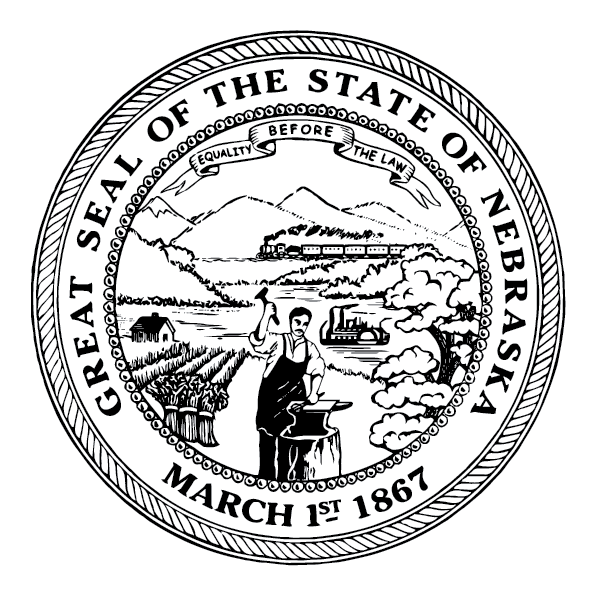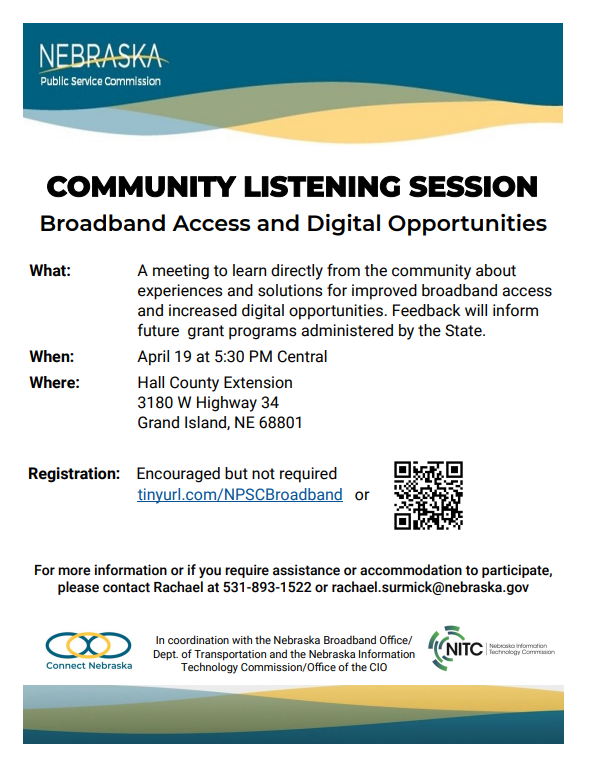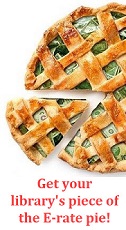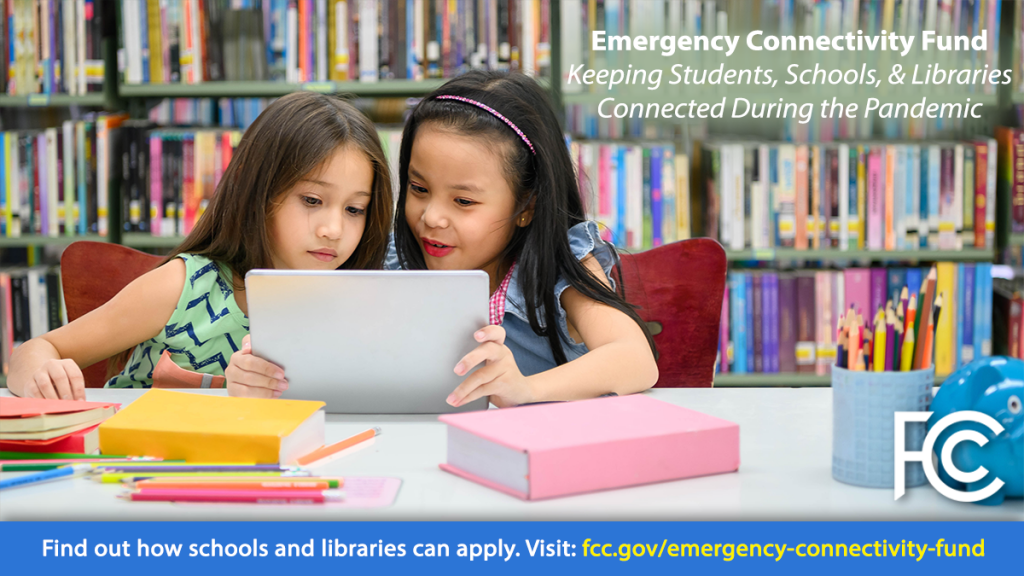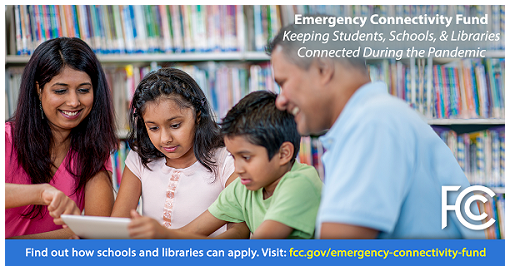Search the Blog
Categories
- Books & Reading
- Broadband Buzz
- Census
- Education & Training
- Friday Reads
- General
- Grants
- Information Resources
- Library Management
- Nebraska Center for the Book
- Nebraska Libraries on the Web
- Nebraska Memories
- Now hiring @ your library
- Preservation
- Pretty Sweet Tech
- Programming
- Public Library Boards of Trustees
- Public Relations
- Talking Book & Braille Service (TBBS)
- Technology
- Uncategorized
- What's Up Doc / Govdocs
- Youth Services
Archives
Subscribe
Category Archives: Broadband Buzz
Governor Pillen Promotes Broadband Connections During National Library Week
FOR IMMEDIATE RELEASE:
April 27, 2023
FOR MORE INFORMATION:
Laura Strimple, (402) 580-9495
John Gage, (531) 510-8529
Governor Pillen Promotes Broadband Connections During National Library Week
CLAY CENTER, NE – Today, Governor Jim Pillen, together with the Nebraska Library Commission, the Nebraska Public Service Commission (PSC), the Nebraska Department of Transportation (NDOT), and the Clay Center Library, highlighted the Nebraska E-rate Special Construction State Matching Grant Program as an opportunity to further connect Nebraskans by incentivizing new broadband fiber construction to state libraries.
“Reliable and fast broadband internet connection is an essential component to quality of life,” said Governor Pillen. “Internet access impacts work force, education, public health, economic development, and public safety. Schools and libraries serve as the centers of communities and ensuring those institutions are connected to fiber is a priority for the State of Nebraska. These fiber-optic based networks will provide connectivity to resources and expand reach and access to Nebraskans.”
The federal E-rate program provides discounts ranging from 20% to 90% of the costs of eligible services based on 1) the percentage of students eligible for the National School Lunch Program in the school district in which the library is located, and 2) the urban or rural location of the library, based on U.S. Census data.
The state program is designed to maximize federal funds by providing up to 10% in matching support to Nebraska Eligible Telecommunications Carriers (NETCs) to connect E-rate eligible entities with fiber where there is no existing fiber connection. The Nebraska E-rate Special Construction State Matching Grant Program (NUSF-117), administered by the PSC, was established in May 2020 and has allocated $1 million to facilitate the build-out of new fiber to Nebraska libraries and schools participating in the Federal Communications Commission (FCC) E-rate Special Construction Program.
To best serve the needs of stakeholders, the PSC is seeking comments on its E-rate Special Construction Matching Funds program, including whether modifications should be made, what services are supported and whether existing funding is sufficient or needs to be increased. Libraries can learn more about the proposed enhancements and provide comment by visiting the E-rate Special Construction page of the PSC website and clicking on the NUSF-117 P.O.#1 link.
“In our commitment to deployment of fiber optic internet to all Nebraska libraries, we applaud the work of the Public Service Commission (PSC) and Governor Pillen’s leadership on these issues,” said Nebraska Library Commissioner Director Rod Wagner. “We encourage all Nebraska libraries to provide comments to the PSC during this open comment period.”
“I’m thankful for the financial assistance of the Nebraska E-rate Special Construction State Matching Grant program to install fiber at our library. We have participated in the federal E-rate program for 24 years,” said Clay Center Public Library, Director Cheryl Green. “These programs enable libraries to provide unlimited online resources, using reliable high-speed digital broadband. I encourage other Nebraska libraries to participate in the Nebraska E-rate Special Construction State Matching Grant program to install fiber-optic connectivity at their library.”
Libraries and schools are encouraged to participate in the process by providing comment responses to questions posed in the NUSF-117 P.O.1 docket. Initial comments may be filed on or before Friday, May 26, at 5 p.m. (CT) and reply comments may be filed on or before Friday, June 16, at 5 p.m. (CT) by email to psc.nusf-filings@nebraska.gov.
“Our state libraries help to keep our communities connected,” said PSC District 4 Commissioner Eric Kamler. “Through the State E-rate program, we can help provide support for new fiber construction to these essential public institutions.”
Information on the E-rate program in general can be found at nlc.nebraska.gov/erate/ and the PSC website at E-rate Special Construction.
###
The most up-to-date news releases from the Nebraska Library Commission are always available on the Library Commission Website, http://nlc.nebraska.gov/publications/newsreleases.
Broadband Access and Digital Opportunities Community Listening Sessions in April
Please join for a series of Community Listening Sessions to learn more about community needs and desires for improving broadband access and increasing digital opportunities. Three sessions will be held in April (details below). A future announcement will follow about sessions in May and June .
- April 19 at 5:30 pm central in Grand Island | Hall County Extension, 3180 W. Highway 34
- April 26 at 12:00pm central in Niobrara | Niobrara Village Fire Hall, 259 Spruce Avenue
- April 26 at 5:00pm central in Norfolk | Norfolk Public Library, 308 W. Prospect Street
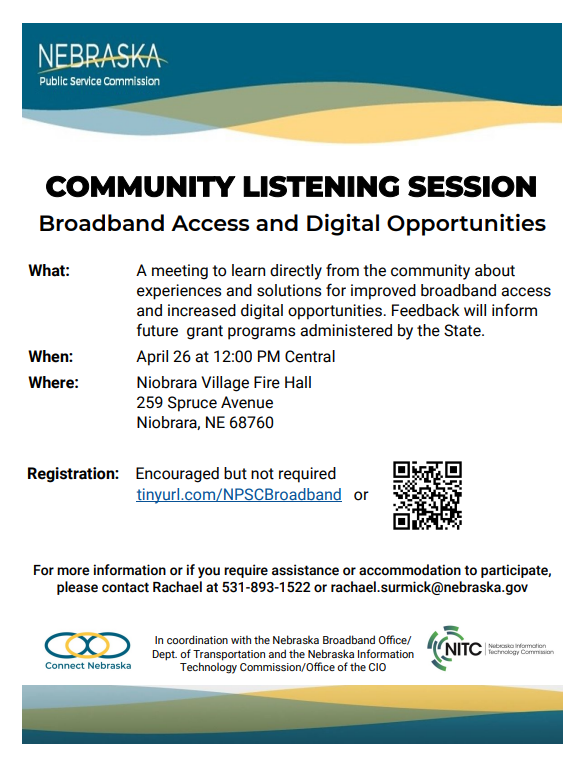
Anyone requiring reasonable accommodation to participate should reach out to:
Rachael Surmick
Broadband Outreach Coordinator
Nebraska Public Service Commission
Office: (402) 471-3101
Cell: (531) 893-1522
Toll Free: (800) 526-0017
rachael.surmick@nebraska.gov
Registration is encouraged but not required. Register here.
Posted in Broadband Buzz, General, Information Resources
Leave a comment
Nebraska Library Commission Challenges the FCC’s Broadband Map On Behalf of Nebraska’s Public Libraries
FOR IMMEDIATE RELEASE:
March 28, 2023
FOR MORE INFORMATION:
Andrew Sherman
402-471-4559
800-307-2665
Nebraska Library Commission Challenges the FCC’s Broadband Map On Behalf of Nebraska’s Public Libraries
The Nebraska Library Commission (NLC) has generated 230 challenges to the Federal Communications Commission’s (FCC) National Broadband Map on the behalf of Nebraska’s public libraries.
These challenges are requests to the FCC to update their map ensuring that all of Nebraska’s public libraries are designated as Community Anchor Institutions (CAI) with the correct address and geographic location.Why is this important? The map will be used to achieve Goal #4 in the National Broadband Plan which is “every American community should have affordable access to at least 1 gigabit per second broadband service to anchor institutions such as schools, hospitals and government buildings.” Per the FCC, “An accurate map will help identify the unserved and underserved communities most in need of funding for high-speed internet infrastructure investments.” This map will be used to allocate $42 billion in Broadband Equity, Access, and Deployment (BEAD) funds to states and territories to help expand access to affordable high-speed internet.
In partnership with Nebraska’s State Broadband Office and Public Service Commission, the NLC will be working to ensure that the FCC has accurate data to assist them in the granting of funds so that all Nebraska public libraries can provide high-speed fiber broadband service to the communities they serve.
As the state library agency, the Nebraska Library Commission is an advocate for the library and information needs of all Nebraskans. The mission of the Library Commission is statewide promotion, development, and coordination of library and information services, “bringing together people and information.”
###
The most up-to-date news releases from the Nebraska Library Commission are always available on the Library Commission Website, http://nlc.nebraska.gov/publications/newsreleases.
Posted in Broadband Buzz, General, Public Relations
Leave a comment
E-rate Form 471 Deadline is March 28
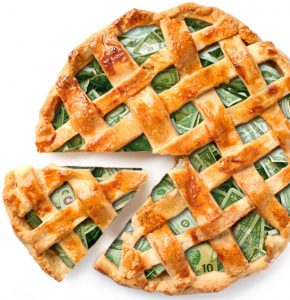
Tuesday, March 28 is the deadline to submit the second form in the E-rate process, Form 471, for Funding Year 2023. The application filing window for Form 471 opened on January 18.
However, we do not recommend waiting until the last day to submit your Form 471! If there are any issues that day, like the E-rate servers are slowed down because it is the last day to submit, or you can’t submit the form due to reasons on your end, such as illness, weather, power outage, etc., then you could miss the deadline and lose out on E-rate altogether.
So, log into your E-rate Productivity Center (EPC) account and submit your Form 471 as soon as you are allowed!
IMPORTANT: Before you file your Form 471, check your Form 470 Receipt Notification for your Allowable Contract Date – the first date you are allowed to submit your 471. Do not submit your 471 before that date! Remember, after you submit your Form 470, you must wait 28 days to submit your Form 471. You can find your Notification within the EPC portal in your News feed.
Do you need help completing your forms? Do you have questions about E-rate? You’re in luck!
The March 16 E-rate News Brief has last-minute tips and links to instructional videos. USAC also conducted a series of office hour webinars focused on E-Rate topics related to FCC Forms 470 and 471 – you can watch the recordings on the USAC Webinars webpage. To keep up on E-rate news, subscribe to the USAC E-rate News Brief.
USAC has a series of video tutorials on the FCC Form 471 Video Series: https://www.usac.org/e-rate/learn/videos/#FCC-Form-471
And more recorded webinars, demos, and training materials are available on the NLC E-rate webpage.
If you have any questions or need any assistance with your E-rate forms, please contact the State E-rate Coordinator for Public Libraries in Nebraska, Christa Porter, 800-307-2665, 402-471-3107.
Posted in Broadband Buzz, Education & Training, Library Management, Technology
Tagged e-rate, erate
Leave a comment
E-rate: Form 470 Deadline is February 28
Two weeks left to file for 2023!
Tuesday, February 28 is the deadline to submit the first form in the E-rate process, Form 470, for the upcoming 2023 Funding Year.
The Filing Window for submitting the second form in the process, Form 471, opened on January 18, and will close on Tuesday, March 28. This makes February 28 the deadline to post your Form 470 to the USAC website, meet the 28-day posting requirement for the competitive bidding process, and submit a Form 471 by the filing window closing date.
However, we do not recommend waiting until the last day to submit your Form 470! If there are any issues that day, like the E-rate servers are slowed down because it is the last day to submit, or you can’t submit the form due to reasons on your end, such as illness, weather, power outage, etc., then you would miss the deadline and lose out on E-rate altogether.
So, get your E-rate process started and submit your Form 470 as soon as possible!
Not sure if you’ve done your 470 yet? No problem! You can look up your E-rate forms to check their status in your E-rate EPC account, to be sure that you have submitted and certified them:
When you are logged into your EPC account, and you are on your Landing Page, scroll all the way to the bottom – under ‘FCC Forms and Post-Commitment Requests’ you can look up your FCC Forms. The Form Type will default to the 470. Choose the Funding Year – 2023. When the results come up, your forms will be listed below the search boxes. If the Status is ‘Certified’ or ‘Committed’, then the Form and the Certification has been received by USAC. If it says ‘Incomplete’ or there are no results, then you still need to submit your 470.
Do you need help completing your forms? Do you have questions about E-rate? You’re in luck!
The January 18 E-rate Special Edition News Brief has detailed tips, steps in the E-rate process, and links to user guides and instructional videos. USAC also conducted a series of office hour webinars focused on E-Rate topics related to FCC Forms 470 and 471 – you can watch the recordings on the USAC Webinars webpage. To keep up on E-rate news, subscribe to the USAC E-rate News Brief.
And more recorded webinars, demos, and training materials are available on the NLC E-rate webpage.
If you have any questions or need any assistance with your E-rate forms, please contact Christa Porter, Nebraska’s State E-rate Coordinator for Public Libraries, 800-307-2665, 402-471-3107.
E-rate Form 471 Application Filing Window Opens Today
The E-rate Form 471 application filing window for Funding Year 2023 opened today at noon EST and will close on Tuesday, March 28 at 11:59 pm EDT. You may now log on to the E-rate Productivity Center (EPC) and file your FCC Form 471 for FY2023.
This makes Tuesday, February 28, the deadline to post your Form 470 to the USAC website, meet the 28-day posting requirement for the competitive bidding process, and submit a Form 471 by the filing window closing date.
However, we do not recommend waiting until the last day to submit your Form 470! If there are any issues that day, like the E-rate servers are slowed down because it is the last day to submit, or you can’t submit the form due to reasons on your end, such as illness, weather, power outage, etc., then you would miss the deadline and lose out on E-rate altogether. So, get your E-rate Form 470 submitted as soon as possible!
IMPORTANT: Before you file your Form 471, check your Form 470 Receipt Notification for your Allowable Contract Date – the first date you are allowed to submit your 471. Do not submit your 471 before that date! Remember, after you submit your Form 470, you must wait 28 days to submit your Form 471. You can find your Notification within the EPC portal in your News feed.
Do you need help completing your forms? Do you have questions about E-rate? You’re in luck!
Today’s E-rate Special Edition News Brief has detailed tips and instructions, as well as information about upcoming online training opportunities from USAC. To keep up on E-rate news, subscribe to the USAC E-rate News Brief.
And more recorded webinars, demos, and training materials are available on the NLC E-rate webpage.
If you have any questions or need any assistance with your E-rate forms, please contact the State E-rate Coordinator for Public Libraries in Nebraska, Christa Porter, 800-307-2665, 402-471-3107.
Posted in Broadband Buzz, Education & Training, Library Management, Technology
Tagged e-rate, erate
Leave a comment
E-rate Form 471 FY2023 Application Filing Window Dates Announced

of the E-rate pie!
From the USAC website:
FY2023 Application Filing Window Dates Announced
The FCC Form 471 Application Filing Window for Funding Year 2023 will open on Wednesday, January 18, 2023 at noon EST and close on Tuesday, March 28, 2023 at 11:59:59 EDT. You can read the USAC announcement for full details.
To prepare for the window opening:
- If you haven’t already done so, file your FCC Form 470 now! You do not have to wait for the Form 471 window to open.
- To file your FCC Form 470, log into the E-Rate Productivity Center (EPC). You must wait 28 days after your FCC Form 470 is posted to the USAC website before you can close your competitive bidding process, select a service provider, sign a contract (if applicable), and submit an FCC Form 471. If you issue an RFP after the FCC Form 470 is posted, you must wait 28 days from the release of the RFP to select a service provider.
- Tuesday, February 28, 2023 is the deadline to post your FCC Form 470 to the USAC website or issue an RFP and still complete all of these actions before the window closes.
- Update Your EPC Profile During the Administrative Window – Update your EPC profile by January 16, 2023, at 11:59 p.m. EST. Review your EPC profile and confirm all of your information is accurate including your organization’s name, address, and other details. Your profile is currently unlocked and available for you to insert any further updates, but will be locked again before the 471 Filing Window opens. Libraries should confirm their square footage, main branch, and public school district of the main branch information is correct and that any bookmobiles or kiosks are included.
You can find additional resources and instructions for using the EPC on the USAC website and on the NLC’s E-rate website.
Please contact Christa Porter , Nebraska State E-rate Coordinator for Public Libraries, if you have any questions or need any assistance submitting your E-rate forms.
Posted in Broadband Buzz, General, Library Management, Technology
Tagged e-rate, erate
Leave a comment
‘E-rate: What’s New for 2023?’ Recording now available
The recording and presentation slides of the E-rate: What’s New for 2023? online workshop are now available.

of the E-rate pie!
What is E-rate? How can my library benefit from E-rate? How do I apply for E-rate?
E-rate is a federal program that provides discounts to schools and public libraries on the cost of their Internet Access and Connections to make these services more affordable. This includes Broadband, Fiber, and Wi-Fi Internet access as well as Internal Connections, such as wiring, routers, switches, and other network equipment.
The E-Rate Productivity Center (EPC) is your online portal for all E-rate interactions. With your organizational account you can use EPC to file forms, track your application status, communicate with USAC, and more.
In this workshop, Christa Porter, Nebraska’s State E-rate Coordinator for Public Libraries, will explain the E-rate program and show you how to access and use your account in EPC to submit your Funding Year 2023 E-rate application.
If you have any questions or need any assistance with your E-rate forms, visit the NLC E-rate webpage or please contact Christa Porter, 800-307-2665, 402-471-3107.
Posted in Broadband Buzz, Education & Training, Library Management, Technology
Tagged e-rate, erate
Leave a comment
Digital Opportunities for Libraries
The COVID-19 pandemic and recent labor shortages have led to an increase in the number and types of services now delivered online, exacerbating the digital divide. Learn how the Do Space in Omaha, Center for People in Need in Lincoln, and public libraries in Crete, Norfolk, South Sioux City, and Ravenna are addressing the digital divide. The Nebraska Digital Opportunities Spotlight and State Planning Update webinar on Oct. 13 at 10:00 a.m. will also provide an update on Nebraska’s Digital Equity Planning grant.
Event Flyer
Nebraska spotlight speakers include:
• Angela McGraw, Director, Do Space, Omaha–Tech Pack Program
• Joy Stevenson, Director, Crete Public Library–Library Outdoor Space
• Jessica Chamberlain, Director, Norfolk Public Library–Hotspot Lending and Tech Tutor Programs
• Cicely Douglas, Director, South Sioux City Public Library–PLA Digital Literacy Workshop Incentive
• Joy Kyhn, Director, Ravenna Public Library–Makerspace
• Kathy Najjar, EduTech Program Coordinator, Center for People in Need–EduTech Career Development & Google Career Certificate Scholarships
Register at https://zoom.us/webinar/register/WN_r5O4QbFNT5ilZIFuUcCPqg#/registration
The Nebraska State Digital Equity Planning grant is part of the Connect Nebraska Broadband Initiative. The planning grant is being led by the Nebraska Information Technology Commission/Office of the CIO in partnership with the Nebraska Regional Officials Council (NROC) and the Nebraska Library Commission.
ALSO
Community engagement listen sessions are being scheduled across Nebraska to gather information for the Digital Equity Planning Grant. Three listening session focused on older adults, internet use and telehealth are scheduled in October. Learn about resources to help use technology and how telehealth can improve access to care..
Oct. 18, 21 and 26 Listening Sessions on Older Adults, Internet Use and Telehealth
Flyer https://nitc.nebraska.gov/digital_equity/2022Octlisteningsessionsflyer.pdf
The three listening sessions are being held at the Gere Library in Lincoln, Kearney Public Library and Millard Branch Library.
Posted in Broadband Buzz
Leave a comment
‘E-rate: What’s New for 2023?’ Online Workshops Scheduled
‘E-rate: What’s New for 2023?’ workshops are now open for registration! All workshops will be held online only, via GoTo Webinar.
NOTE: This online workshop is being offered on multiple days and at varied times. The same information will be provided at each workshop, so you only need to attend one session. A recorded version will also be made available after all of the live sessions have been held.
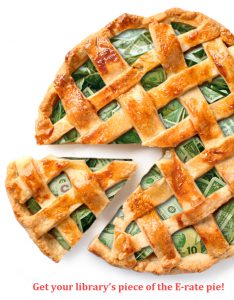
What is E-rate? How can my library benefit from E-rate? How do I apply for E-rate?
E-rate is a federal program that provides discounts to schools and public libraries on the cost of their Internet Access and Connections to make these services more affordable. This includes Broadband, Fiber, and Wi-Fi Internet access as well as Internal Connections, such as wiring, routers, switches, and other network equipment.
The E-Rate Productivity Center (EPC) is your online portal for all E-rate interactions. With your organizational account you can use EPC to file forms, track your application status, communicate with USAC, and more.
In this workshop, Christa Porter, Nebraska’s State E-rate Coordinator for Public Libraries, will explain the E-rate program and show you how to access and use your account in EPC to submit your Funding Year 2023 E-rate application. Dates and times:
- November 15 – 1:00-4:00pm Central / 12:00noon-3pm Mountain
- November 17 – 9:30am-12:30pm Central / 8:30-11:30am Mountain
- November 21 – 1:00-4:00pm Central / 12:00noon-3pm Mountain
- November 22 – 9:30am-12:30pm Central / 8:30-11:30am Mountain
To register for any of these sessions, go to the Nebraska Library Commission’s Training & Events Calendar and search for ‘e-rate 2023’.
Posted in Broadband Buzz, Education & Training, Library Management, Technology
Tagged e-rate
Leave a comment
Get Internet : The Affordable Connectivity Program (ACP)
Learn how President Biden is reducing the cost of high-speed internet and find out if you qualify to sign up.
As part of the Bipartisan Infrastructure Law, President Biden and Vice President Harris worked with Democrats, Republicans, and Independents to create the Affordable Connectivity Program (ACP), which provides eligible households $30 per month off their internet bills. To deliver maximum cost savings to families, the Biden-Harris Administration has secured commitments from 20 leading internet providers to offer ACP-eligible households a high-speed internet plan for no more than $30 per month. Eligible families who pair their ACP benefit with one of these plans can receive high-speed internet at no cost.
Find Out If You Qualify
There are three different ways to qualify for the ACP benefit. You are eligible if you meet any one of the three qualifications below:
- Your income is at or below 200% of the Federal Poverty Guidelines (see chart below)

- You or someone in your household participates in one of these other programs:
- Supplemental Nutrition Assistance Program (SNAP), formerly known as Food Stamps
- Medicaid
- Special Supplemental Nutrition Program for Women, Infants, and Children (WIC)
- Supplemental Security Income (SSI)
- Federal Public Housing Assistance (FPHA)
- Veterans Pension and Survivors Benefit
- Free and Reduced-Price School Lunch Program or School Breakfast Program, including at U.S. Department of Agriculture (USDA) Community Eligibility Provision schools
- Federal Pell Grant (received in the current award year)
- Lifeline
- Certain Tribal assistance programs, including Bureau of Indian Affairs General Assistance, Head Start (only households meeting the income qualifying standard), Tribal Temporary Assistance for Needy Families (Tribal TANF), and Food Distribution Program on Indian Reservations
- You meet the eligibility criteria for a participating broadband provider’s existing low-income internet program.
How To Sign Up for the Affordable Connectivity Program
Step 1: Claim Your Affordable Connectivity Program Benefit.
- You can send in an application by mail:
- You can sign up through your existing internet service provider if it participates in the program. Participating companies may ask you to apply through their company’s own application process.
Step 2: Contact a participating internet service provider to choose an internet plan.
- Once your application is approved, contact a participating internet service provider to choose a plan and apply your benefit to that plan.
- More information on how to apply can be found at https://acpbenefit.org/how-to-apply/ or by calling (877) 384-2575.
Participating Service Providers
These internet service providers offer a high-speed internet plan for $30 per month or less. If you apply your ACP benefit to one of these plans, you will have no out-of-pocket cost for internet.
- Allo Communications
- AltaFiber (and Hawaiian Telecom)
- Altice (Optimum and Suddenlink)
- Astound
- AT&T
- Breezeline
- Comcast
- Comporium
- Cox Communications
- Frontier
- IdeaTek
- Jackson Energy Authority
- Mediacom
- MLGC
- Spectrum (Charter Communications)
- Starry
- Verizon (Fios only)
- Vermont Telephone Company
- Vexus Fiber
- Wow! Internet, Cable and TV
You can also choose to apply your ACP benefit to a different provider. There are over 1,300 providers that accept the ACP benefit. To find one near you, visit https://acpbenefit.org/companies-near-me/.
Frequently Asked Questions (FAQs)
What if I also need help getting a tablet or computer?
ACP-eligible households can also receive a one-time discount of up to $100 to purchase a laptop, desktop computer, or tablet from certain participating providers, with a small copay. To get a discounted device, contact a participating provider. The providers offering discounted devices are listed at https://www.fcc.gov/affordable-connectivity-program-providers
How much is my Affordable Connectivity Program benefit?
Most eligible families can receive a benefit of up to $30 per month applied to the cost of their internet service. ACP-eligible households who live on Tribal lands are eligible for a benefit of up to $75 per month.
Are these plans fast?
Yes – they offer a minimum of 100 Mbps download speed, which is fast enough for a typical family of 4 to video conference, stream movies or TV, and more.
‘E-rate: What’s New for 2022?’ Recording now available

Get your library’s piece of the E-rate pie!
The recording and presentation slides of the E-rate: What’s New for 2022? online session are now available.
What is E-rate? How can my library benefit from E-rate? How do I apply for E-rate?
E-rate is a federal program that provides discounts to schools and public libraries on the cost of their Internet Access and Connections to make these services more affordable. This includes Broadband, Fiber, and Wi-Fi Internet access as well as Internal Connections, such as wiring, routers, switches, and other network equipment.
The E-Rate Productivity Center (EPC) is your online portal for all E-rate interactions. With your organizational account you can use EPC to file forms, track your application status, communicate with USAC, and more.
In this workshop, Christa Porter, Nebraska’s State E-rate Coordinator for Public Libraries, will explain the E-rate program and show you how to access and use your account in EPC to submit your Funding Year 2022 E-rate application.
If you have any questions or need any assistance with your E-rate forms, visit the NLC E-rate webpage or please contact Christa Porter, 800-307-2665, 402-471-3107.
Posted in Broadband Buzz, Education & Training, Library Management, Technology
Tagged e-rate, erate
Leave a comment
Over $11.2 Million in First Emergency Connectivity Funding Wave Awarded to Nebraska Schools and Libraries
Congratulations to all Nebraska schools and libraries who have been funded!
If you haven’t received your ECF Funding Commitment Decision Letter (FCDL) yet, don’t panic! There are more Waves to come as USAC processes more applications.
As soon as you do receive your ECF FCDL, you should also view the e-learning modules, live trainings, recordings of past trainings and webinars, and register for USAC’s weekly office hour sessions at https://www.emergencyconnectivityfund.org/training/
To stay informed about the ECF program, sign up for the weekly ECF Newsletters, and read the previous newsletters, at https://www.emergencyconnectivityfund.org/stay-informed/
From the FCC Press Release:
Second Filing Window Set for September 28 to October 13 Providing Funding for Eligible Equipment and Services Between July 1, 2021 and June 30, 2022: https://www.emergencyconnectivityfund.org/
WASHINGTON, September 24, 2021—The Federal Communications Commission today announced that it is committing $1,203,107,496.88 for 3,040 schools, 260 libraries, and 24 consortia that applied for support from the $7.17 billion Emergency Connectivity Fund Program. This first wave of funding commitments will provide students, school staff and library patrons in all 50 states and Guam, Puerto Rico, and the District of Columbia access to the devices and broadband connectivity they need to support their off-campus education needs. The funding will support 3,081,131 devices and 774,115 broadband connections and help connect over 3.6 million students who, according to their schools, would otherwise lack devices, broadband access, or both.
Read the full press release and details about which schools and libraries will receive funding in this first Wave at:
https://www.fcc.gov/document/fcc-commits-over-12b-first-emergency-connectivity-funding-wave
Posted in Broadband Buzz, Grants, Technology, Youth Services
Leave a comment
FCC Emergency Connectivity Fund Program: Resources, Training, and Application Window Announced
In addition to the USAC training sessions listed below, the Nebraska Library Commission held an ‘FCC Emergency Connectivity Fund (ECF) – Overview and Q&A‘ webinar on June 24, 2021. Registration for the original session is not required to view the archived recording and presentation slides.
Get ready! The Emergency Connectivity Fund Program will provide up to $7.17 billion in support to schools and libraries for the purchase of laptop and tablet computers, Wi-Fi hotspots, modems, routers, and broadband connectivity during the COVID-19 pandemic for use by students, school staff, and library patrons who would otherwise lack connected devices and/or broadband connections sufficient to fully engage in remote learning.
The FCC and USAC will open the first Emergency Connectivity Fund Program application filing window on Tuesday, June 29, 2021 at noon ET, which will fund equipment and services for the upcoming 2021-22 school year. The first application filing window will be open for 45 days, during which applicants will be able to submit requests for funding for purchases to be made between July 1, 2021 and June 30, 2022 to meet the needs of students, school staff, and library patrons who would otherwise lack access to basic educational opportunities and library services. The FCC’s announcement of the funding window is available on their website.
Stay Informed
USAC will conduct outreach and training about the Emergency Connectivity Fund Program. Register for an Emergency Connectivity Fund Program overview training. USAC will repeat the training several times to allow all potential program participants to join a session and will post recordings of webinars when they are completed.
- Wednesday, June 16 @ 2:00 p.m. ET: Emergency Connectivity Fund Overview Webinar for E-rate Participants – Register
- Thursday, June 17 @ 2:00 p.m. ET: Emergency Connectivity Fund Overview Webinar for New (Non E-rate) Participants – Register
- Thursday, June 17 @ 4:00 p.m. ET: Emergency Connectivity Fund Overview for Tribal Applicants – Register
- Wednesday, June 23 @ 3:00 p.m. ET: Emergency Connectivity Fund Overview for Potential Applicants – Register
USAC will post Program e-learning modules on the website and host weekly office hours where applicants and service providers can ask questions and get information about the Emergency Connectivity Fund Program application process.
Visit the Emergency Connectivity Fund Program website to view trainings, access e-learning modules and register for office hour sessions.
Get Ready
To help you prepare for the Emergency Connectivity Fund Program filing window, there are two steps you can take now, before the window opens:
- Obtain an FCC Registration Number or locate your existing registration number if you already have one.
Schools, libraries, and consortia of schools and libraries that intend to submit a funding application for the Emergency Connectivity Fund Program, as well as service providers that agree to invoice on behalf of applicants, should make sure they have an FCC Registration Number. If a program participant previously registered with the FCC, they do not need to complete this step again. Schools. libraries, and services providers can obtain an FCC Registration Number by visiting the FCC Commission Registration System (CORES) and completing the registration process.
- Register with SAM.gov so that you can receive support through the Emergency Connectivity Fund Program.
Applicants can apply for the Emergency Connectivity Fund Program before their SAM.gov registration is approved, but will not be able to receive program funding until they have completed their registration. Applicants and service providers who agree to invoice on behalf of applicants must have an active registration with SAM.gov to receive support through the Program.
Emergency Connectivity Fund Program participants do not need to re-register at SAM.gov if they already have an active SAM.gov registration.
Processing a SAM.gov registration request can take more than a week, so USAC recommends schools, libraries, and service providers who are invoicing on behalf of applicants begin the process early.
More detail on the Program is available in the FCC Order that established the Emergency Connectivity Fund Program.
To learn more, please visit EmergencyConnectivityFund.org and sign up for Emergency Connectivity Fund Program emails.
Posted in Broadband Buzz, Education & Training, Technology
2 Comments
2020 Public Library Survey Data are Now Available
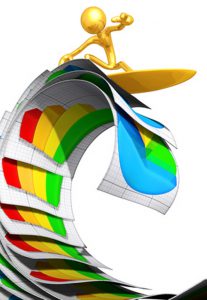 The 2020 FY public library survey data are now available on the NLC website. This is preliminary data (meaning that it has not yet been certified by IMLS) so keep in mind that it is subject to change. Thanks to all of you who submitted your statistics. Historical data (back to 1999) are also available on our website. The next survey cycle begins in November, but you should be collecting those statistics now. If you are a new library director, check out the Bibliostat guide.
The 2020 FY public library survey data are now available on the NLC website. This is preliminary data (meaning that it has not yet been certified by IMLS) so keep in mind that it is subject to change. Thanks to all of you who submitted your statistics. Historical data (back to 1999) are also available on our website. The next survey cycle begins in November, but you should be collecting those statistics now. If you are a new library director, check out the Bibliostat guide.
NCompass Live: The ‘Toward Gigabit Libraries’ Project Update
Improve your library’s broadband service with the Toward Gigabit Libraries Toolkit on next week’s FREE NCompass Live webinar on Wednesday, September 2 at 10am CT.
 Join us for an update on the Toward Gigabit Libraries project, funded by the Institute for Museum and Library Services (IMLS), designed to help public and tribal librarians learn about their current broadband infrastructure and internal information technology (IT) environment. The project has been awarded a new grant from the IMLS to fund an expansion of the Towards Gigabit Libraries toolkit to increase tech capacities in rural, tribal & urban libraries. Through the use of the project’s “Broadband Toolkit” and customizable “Broadband Improvement Plan”, librarians have become better equipped to improve their broadband services and become stronger advocates for their libraries’ broadband infrastructure needs.
Join us for an update on the Toward Gigabit Libraries project, funded by the Institute for Museum and Library Services (IMLS), designed to help public and tribal librarians learn about their current broadband infrastructure and internal information technology (IT) environment. The project has been awarded a new grant from the IMLS to fund an expansion of the Towards Gigabit Libraries toolkit to increase tech capacities in rural, tribal & urban libraries. Through the use of the project’s “Broadband Toolkit” and customizable “Broadband Improvement Plan”, librarians have become better equipped to improve their broadband services and become stronger advocates for their libraries’ broadband infrastructure needs.
Presenters: Carson Block, Library Technology Consultant; Stephanie Stenberg, Director, Internet2 Community Anchor Program (CAP); Holly Woldt, Library Technology Support Specialist, Nebraska Library Commission; Tom Rolfes, Education I.T. Manager, Nebraska Office of the CIO/NITC.
Upcoming NCompass Live shows:
- Sept. 9 – Discount Shopping with the NLC
- Sept. 23 – NLC Grants for 2021
- Sept. 30 – Pretty Sweet Tech
- Oct. 21 – Migrating to an Open-Source ILS in an Academic Library: How to Celebrate Successes and Bounce Back from Problems
For more information, to register for NCompass Live, or to listen to recordings of past events, go to the NCompass Live webpage.
 NCompass Live is broadcast live every Wednesday from 10am – 11am Central Time. Convert to your time zone on the Official U.S. Time website. The show is presented online using the GoToWebinar online meeting service. Before you attend a session, please see the NLC Online Sessions webpage for detailed information about GoToWebinar, including system requirements, firewall permissions, and equipment requirements for computer speakers and microphones.
NCompass Live is broadcast live every Wednesday from 10am – 11am Central Time. Convert to your time zone on the Official U.S. Time website. The show is presented online using the GoToWebinar online meeting service. Before you attend a session, please see the NLC Online Sessions webpage for detailed information about GoToWebinar, including system requirements, firewall permissions, and equipment requirements for computer speakers and microphones.
Nebraska’s Great Broadband Divide: Living Without High-speed Internet Access
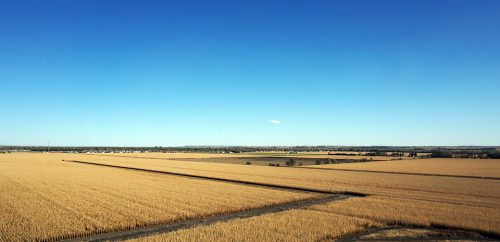
On August 2, 2020 CBS Sunday Morning aired a story called “The Great Broadband Divide: Living Without High-speed Internet Access.” The story is about tens of millions of Americans in rural areas who are unable to obtain broadband internet and illustrates how it hampers business development and people trying to make a living in rural areas across the country. It also puts students at a distinct disadvantage when competing with others who don’t have these limitations, especially in this time of a pandemic.
Broadband is defined by the Federal Communications Commission (FCC) as achieving a speed of 25 mega bits per second (Mbps). The highest broadband speed available in the US right now is 2000 Mbps, the average speed is 129 Mbps, and 25 Mbps is what the FCC defines as broadband, which is not very fast, especially when streaming video or downloading/uploading large files. According to the FCC there are 20 – 23 million people in the U.S. without broadband, but Microsoft did a study that showed 162 million Americans lack broadband access. Gigi Sohn, who worked at the FCC during the Obama administration explained that “the FCC says is, if you serve one person in a census block, that means you’re serving everybody in the census block.”
https://www.cbsnews.com/news/the-great-broadband-divide-living-without-high-speed-internet-access/?ftag=CNM-00-10aab6i&linkId=95801518#app
A new report on the homework gap by Common Sense Media “Closing the K-12 Digital Divide in the Age of Distance Learning,” published in 2020, shows that 29% of Nebraska students, 95,834 of them are lacking adequate high-speed connection. This report also cited that 21%, or 68,888 of all Nebraska students, lack a device to access the internet.
Because the data is not collected at the address-level by student household the measures are elusive, however school districts are being encouraged to collect the data this fall. State Senator Tom Brandt of Plymouth, District 32, who introduced a bill (LB996) https://journalstar.com/legislature/fcc-to-invest-20b-in-rural-broadband-senator-wants-nebraska-to-be-first-in-line/article_6d4b173a-d93c-5da7-84cc-a68369a56736.html to create the Broadband Data Improvement Program, will help Nebraska identify areas without high-speed internet. However, we do have the following information from the U.S. Census – American Community Survey from 2018.
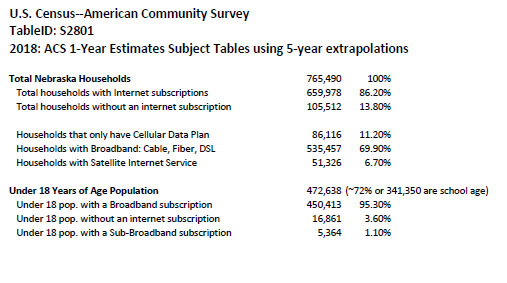
This lack of broadband availability in libraries is a focus of the Library Commission’s “Better Broadband for Nebraska Libraries” initiative. Holly Woldt & Cynthia Nigh, along with other agency team members on the Library Infrastructure Broadband Committee are working towards assisting with discovering, advocating and assisting with obtaining funding and providing information to libraries looking for ways to improve their internet speed.
If you would like to see specific information about your county’s broadband statistics follow this link and select your county.
http://nlc.nebraska.gov/stats/broadband/

Posted in Broadband Buzz, Library Management, Technology
Leave a comment
2019 Public Library Survey Data is Now Available
 The 2019 FY public library survey data is now available on the NLC website. This is preliminary data (meaning that it has not yet been certified by IMLS) so keep in mind that it is subject to change. Thanks to all of you who submitted your statistics. Historical data (back to 1999) is also available on our website. The next survey cycle begins in November, but you should be collecting those statistics now. If you are a new library director, check out the Bibliostat guide.
The 2019 FY public library survey data is now available on the NLC website. This is preliminary data (meaning that it has not yet been certified by IMLS) so keep in mind that it is subject to change. Thanks to all of you who submitted your statistics. Historical data (back to 1999) is also available on our website. The next survey cycle begins in November, but you should be collecting those statistics now. If you are a new library director, check out the Bibliostat guide.
New State Funding Source for Fiber Construction for Nebraska Public Libraries

The Nebraska Public Service Commission has issued an Order establishing the E-Rate Special
Construction State Matching Grant Program (NUSF-117) as a way to help facilitate Federal Communication Commission (FCC) with the build-out of new fiber to Nebraska libraries and schools. This new grant program is designed to maximize federal support through the FCC E-rate Special Construction Program. Nebraska public libraries are able to apply for up to 10% of the total fiber build-out construction cost to the library with these grant funds. The approved state funds provide a match for the federal E-rate funds (also up to 10%) to be paid toward the fiber build-out construction cost.
The E-rate Special Construction State Matching Grant Program is a four year program with one million dollars available to library applicants that have been approved by the both the state and federal programs.
“I commend the Nebraska Public Service Commission for creating the E-Rate Special Construction State Matching Grant Program. The matching funds will be a significant incentive to help Nebraska libraries install fiber connections for high-speed internet service. Libraries that capitalize on fiber build-outs using this state and federal funding opportunity will be able to fulfill their mission of serving the public’s demand for technology resources,” said Rod Wagner, Director Nebraska Library Commission.
Currently about 40 percent of the 247 Nebraska public libraries report internet speeds of less than 12 Mbps.
Often Nebraska access to free Wi-fi in rural areas is located at the local public library. The library may also be the only location for many miles where a traveler or local citizen can assess a printer/fax machine or computer free. School-age children in rural communities use the free Wi-fi to use their Chrome Books and complete their homework assignments. Local citizens who do not have access to a computer a home can complete online government forms and address medical concerns with providers that offer telehealth services at their local library. The local library has a critical role in providing access to the internet in rural communities. The Nebraska Rural Broadband Task Force included in its recommendations, Legislative Bill LB-992, that Nebraska Universal Services Fund be used to provide the matching funding source for fiber build-outs to assist libraries to upgrade rural libraries’ access to fiber.
The Nebraska Library Commission will host a webinar on June 18 to provide local library directors and opportunity to learn more about the grant program.
Nebraska Public Service Commission news release, PSC Initiates Grant Program to Help Bring Broadband to Libraries & Schools .
For more information, contact Holly Woldt, 402-471-4871
Posted in Broadband Buzz, Grants
Leave a comment
Broadband Facts for Your County
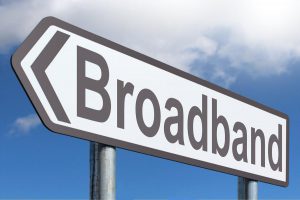
Is your community wanting to work to improve the broadband speed in your library? Often times, library speeds lag behind what the community really needs, or the community might not understand how impactful improving the library internet might be. Sometimes, it is difficult to even determine what your community needs might be. One first step in having these conversations is to look over our now available broadband fact sheets. These are available for every county in Nebraska, and are intended to be used to help start community, county-wide or regional discussions about broadband availability, adoption, and digital inclusion. More information, including data sources and suggested discussion questions are also included. To view or download these, go to the main broadband page on the data services portion of our website. From there, you have the option to select by county, or pull up a map and click on a county for the fact sheets. The main page also has a broadband discussion guide, to help you with these conversations.
